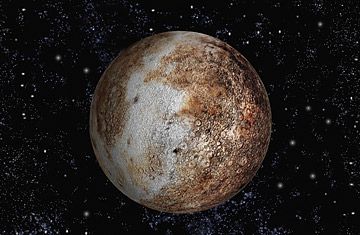
Correction appended Dec. 9, 2014
On Saturday, the New Horizons space probe was roused from hibernation for the last time before its July close encounter with Pluto. TIME caught up with mission’s principal investigator, Alan Stern of the Southwest Research Institute, and asked him to come up with five cool things we’ll learn about Pluto during the encounter, and five cool things you should know about the space probe itself.
Given that Stern has been thinking about Pluto for decades, and working on New Horizons for nearly 15 years, it should come as no surprise that he rattled off his top 10 without breaking a sweat.
TOP FIVE THINGS WE’LL LEARN ABOUT PLUTO
Does Pluto have craters?
You’d think so, since Pluto, once believed to be all alone at the edge of the Solar System, is just part of the Kuiper Belt, a swarm of billions, or even trillions, of icy bodies that lie out beyond Neptune. The smaller ones have presumably been peppering Pluto for billions of years. But Pluto’s surface might consist of a thick layer of nitrogen ice, which would be soft, mushy and unlikely to form long-lasting craters. There could even be liquid nitrogen on the surface, which could smooth out any impact craters.
Does Pluto have an ocean?
It just might, down below the surface. “The deeper you go, the higher the pressure,” Stern said. That makes the interior warmer than the surface, which means it could get warm enough for ice to melt into water. New Horizons could detect the ocean indirectly, by measuring Pluto’s shape to high accuracy and by looking for cracks that might signal a solid crust flexing atop an underground ocean.
How many moons does Pluto have?
“We know it’s got five, based on observations from Earth,” Stern said. “But how many more are there? Another five? Fifteen? Fifty? All of these are possible. However many there are, they might have been captured when they ventured too close to the planet, or they might have been created in a huge impact that created Pluto’s large moon, Charon, or it might be a combination. New Horizons could answer that question too.
Does Pluto have rings?
Could be. You can’t tell from Earth, but Pluto’s moons Nix and Hydra have weak enough gravity that impacts from smaller objects could kick up dust that would fly off into space and potentially form rings about Pluto itself.
Does Pluto have geysers, volcanoes or other geological activity?
You’d think a world that averages 3.67 billion miles away from the sun would be deep-frozen, but if there’s an underground ocean, it could trigger geysers like those on Saturn’s moon Enceladus, volcanoes like those on Jupiter’s moon Io, or some sort of plate tectonics, as on Jupiter’s moon Europa.
PLUS: ONE THING WE DEFINITELY WON’T LEARN
Is Pluto a planet?
Depends on who you ask, and that’s not likely to change after the encounter. If you ask Stern, it definitely is. He’s more than fine with your calling it a dwarf planet. In fact, he points out, “I invented the term.” What he doesn’t get is why the International Astronomical Union came out with a new definition of “planet” back in 2006 (and just a few months after New Horizons launched) that excluded dwarf planets. “Does that mean a dwarf evergreen should be considered an evergreen?” asks Stern, pointedly? In a recent debate at Harvard, the best explanation the IAU’s representative could come up with for keeping dwarf planets out of the ranks of planets was basically that otherwise there would be too many planets to remember. Which might be true, but it’s not all that persuasive.
FIVE COOL THINGS ABOUT THE NEW HORIZONS SPACECRAFT
It’s smaller and much simpler than the Voyager probes that visited Jupiter, Saturn and the other outer worlds (except Pluto!) in the 1970s and 1980s.
“It’s like a modern tablet compared with an old mainframe computer,” says Stern
It was approved by NASA after five earlier Pluto missions failed to make the cut.
“It was mostly due to cost overruns,” says Stern. “They kept adding extra capabilities like ornaments on a Christmas tree.”
It’s the fastest spacecraft ever to leave Earth.
New Horizons took off for Pluto at a record 36,000 m.p.h.
During closest approach, about 8,000 miles from Pluto’s surface, New Horizons’ cameras will be able to see objects just two miles across.
That’s pretty darned small.
Pluto may not be New Horizons’ last stop.
Pending NASA approval, the probe should still have enough fuel to reach a second, smaller Kuiper Belt object a couple of years after the Pluto encounter. At least two potential targets have already been identified.
The original version of this story misstated the minimum size of the objects New Horizons can see. They are less than 100 yards across.
More Must-Reads from TIME
- How Donald Trump Won
- The Best Inventions of 2024
- Why Sleep Is the Key to Living Longer
- Robert Zemeckis Just Wants to Move You
- How to Break 8 Toxic Communication Habits
- Nicola Coughlan Bet on Herself—And Won
- Why Vinegar Is So Good for You
- Meet TIME's Newest Class of Next Generation Leaders
Contact us at letters@time.com